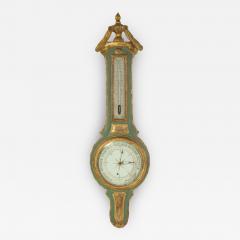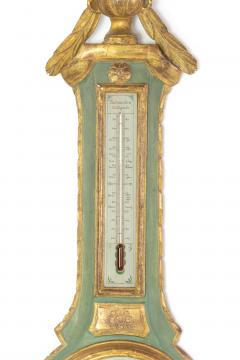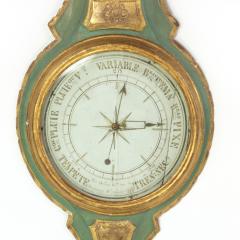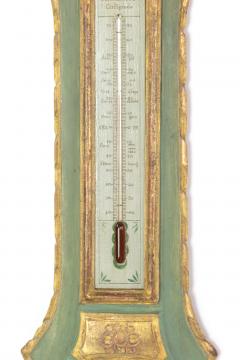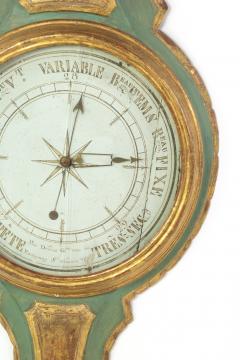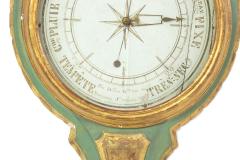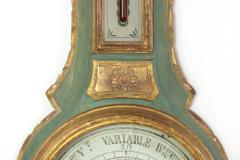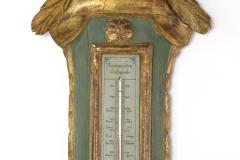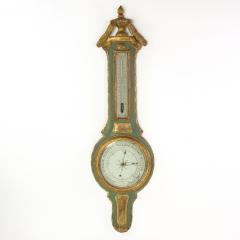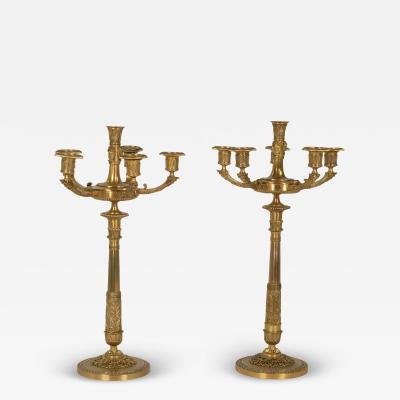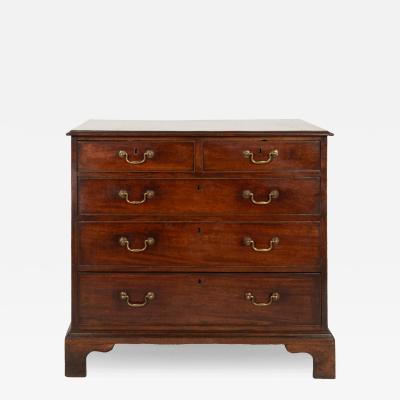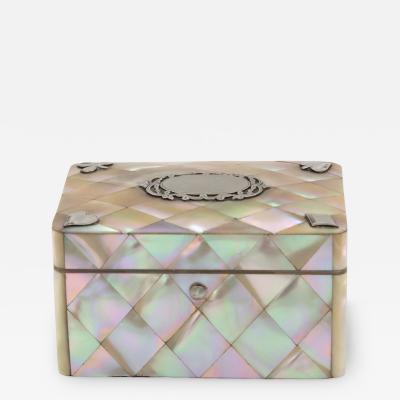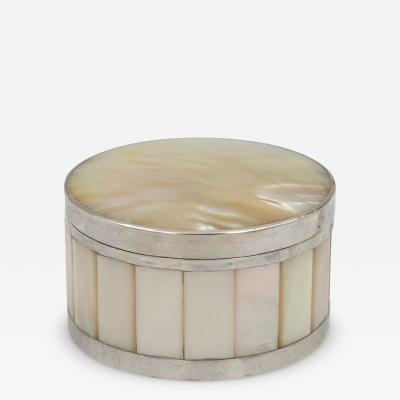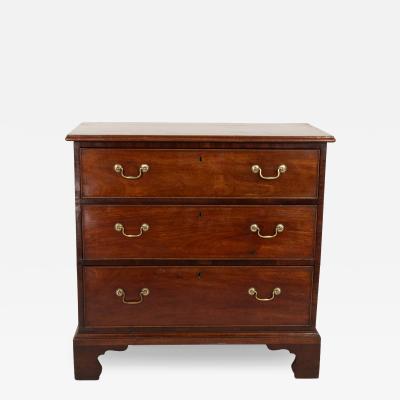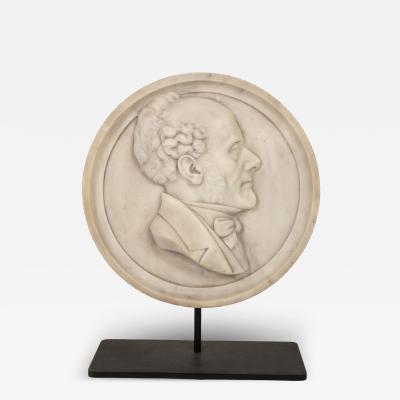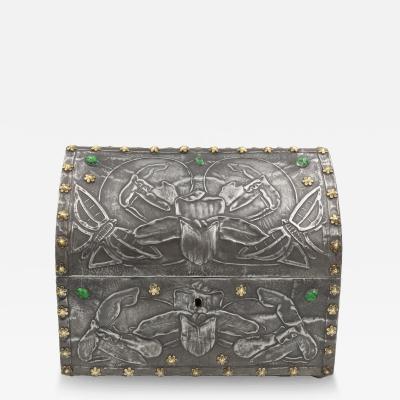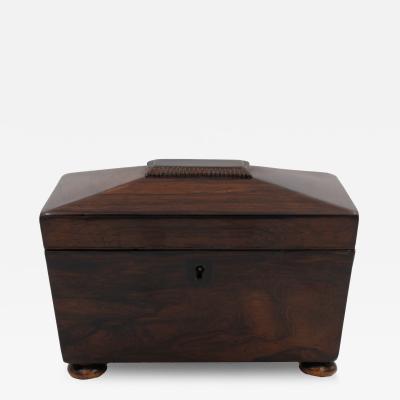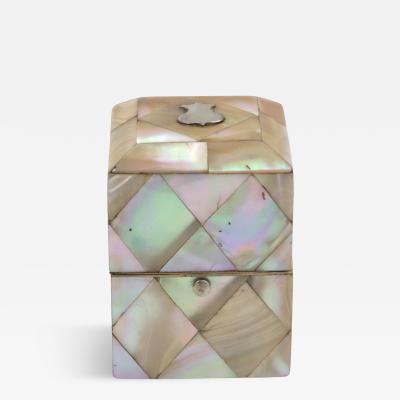19th Century Green & Gilt, Carved Thermometer Over Barometer, Circa 1850
-
Description
A Mid-19th century green and gilt, carved thermometer over barometer with a flame-pot finial, circa 1850. The gilded flame-pot finial crowns a stick thermometer over the round “wheel” barometer; in green paint and gilt swag & decoration.
height: 40 in. 101.5 cm., width: 13 in. 33 cm., depth: 2 in. 5 cm.
Temperature indices correlate to commonly-held heat and cold benchmarks. Thermomètre Centigrade
Senegal 1
Metinique 2
Bains ord 3
Vers à Soye Silkworms 4
Serres chaudes 5
Orangers 6
Paris 1746, 1799, 1830 7
Petersbourg 8
Tempete – Storm
Gde Pluie – “Gde Pluie” for “Grande Pluie” (Strong Rain)
Pluie ou Vt – “Pluie ou Vent” (Rain or Wind).
Variable – Change
BeauTemps – Good
Beau Fixe – Fair weather
Tres Sec – Dry
Sur un baromètre, “beau temps” indique… le beau temps. Quand le baromètre est “au beau”, il indique du beau temps. Et quand il est “au beau fixe”, il indique du beau temps stable.
On a barometer, “good weather” indicates… good weather. When the barometer is “fine”, it indicates good weather. And when it is “steady”, it indicates stable weather.
From the end of the 18th century, the domestic barometer became one of the ‘must-haves’, a thing of science, function and beauty to complement the decor and furnishings and, no doubt, to impress the neighbors. Cases began to reflect the prevailing decorative arts fashions, the most popular of which was the “banjo” barometer. Wheel barometers produced in the mid 18th-19th centuries are works of art by very fine clockmakers of the period. Foil sticker on the back: “M. Gizardin 8 Rue Des Sts Pères Paris VII”. The decorative scientific instrument was originally purchased in the 1960’s at a Paris dealer, M.Gizardin (d. 1976) who was a French actor of some note and later, an antiques dealer at 8 Rue des Saints-Pères.
Micheli du Crest took the supposedly constant temperature of deep cellars and mines as a fundamental fixed point of thermometry, and expected the most extreme temperatures observed on the surface (in Senegal and Kamchaka) would be equally distant from this middle point. Spirit, air, and quicksilver: The search for the “real” scale of temperature, Hasok Chang, Historical Studies in the Physical and Biological Sciences , Vol. 31, No. 2 (2001), pp. 249-284 Published by: University of California Press Stable URL: https://www.jstor.org/stable/10.1525/hsps.2001.31.2.249
Possibly ‘Martinique’.
Bath temperature; warm bath.
Sericulture the production of raw silk by raising silkworms and despite its prominent place in France’s history, is largely forgotten today. In the 18th and 19th centuries, Provence experienced a boom in sericulture that would last until the first world war, with much of the silk shipped north to Lyon. The optimum temperature for normal growth of silkworms is between 20°C and 28°C and the desirable temperature for maximum productivity ranges from 23°C to 28°C. Temperature above 30°C directly affects the health of the worm. ?
Greenhouses, hot greenhouses. Most common greenhouse crops require a temperature range of around 18º-24ºC (64ºF – 75ºF). These temperatures are considered optimal for most common crops, which is why we find them in most greenhouses around the world.
Oranger: orange tree Which were often grown indoors in residences in greenhouse like rooms called Orangeries. The appearance of the French garden in the 17th and 18th centuries was a result of the development of several new technologies in horticulture. One of these was the ability to raise plants from warmer climates in the northern European climate by protecting them inside buildings and bringing them outdoors in pots. The first orangeries were built in France in the 16th century following the introduction of the orange tree after the Italian Wars. The Versailles Orangerie had walls five meters thick, with a double wall that maintains temperatures in winter between 5 and 8 degrees Celsius (41 and 46 °F). Today it can shelter 1055 trees.
Historic cold temps in Paris; Winter 1830 was considered the coldest in the past 300 years. The years between 1740 and 1835 marked the coldest period throughout much of Europe and Russia during the so called “little ice age” (1351-1882) The period around 1750-1825 was considered as cold as ever. As the 18th century drew to a close, two decades of poor cereal harvests, drought, cattle disease and skyrocketing bread prices had kindled unrest among peasants and the urban poor in France. Many expressed their desperation and resentment toward a regime that imposed heavy taxes yet failed to provide relief by rioting, looting and striking. Tensions erupted into the French Revolution of 1789, which some historians have connected to the Little Ice Age. Little Ice Age, Big Consequences by Jennie Cohen, History https://www.history.com/news/little-ice-age-big-consequences
Possibly St. Petersburg, Russia; - More Information
- Dimensions
Sold

















